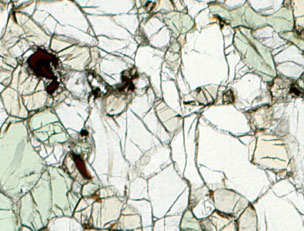
Four-phase spinel lherzolite from the Rio Grande Rift, New Mexico olivine (transparent), clinopyroxne (green), orthopyroxene (tan), spinel (brown/opaque).
Benjamin Byerly and John Lassiter, UT Austin
Clinopyroxene is generally regarded as the primary host of incompatible trace elements in spinel peridotites. This is reflected in the general agreement between cpx and whole-rock trace element patterns in peridotite xenoliths. Clinopyroxenes in peridotite xenoliths from Cerro Chato, NM, USA are LREE-enriched and have large negative HFSE anomalies with respect to the rare earth elements (Ti/Ti*, Hf/Hf*, and Zr/Zr* <1) (Byerly and Lassiter in prep.). Whole-rock trace element patterns generally reflect these trends. However, HFSE anomalies are not always present in whole-rock trace element patterns in the Cerro Chato xenoliths. Disparities in HFSE anomalies between cpx and whole rock may reflect partitioning of HFSE into other phases within the peridotite. Alternatively cpx may not be in equilibrium with the host peridotite because it may have been precipitated from a melt with negative HFSE anomalies relative to REE (e.g. carbonatite or subduction-related magma) percolating through the lithosphere. Disparities between the Lu/Hf ratios of bulk-xenoliths and cpx can have major implications for the use of cpx alone to interpret the Hf isotopic evolution of mantle xenoliths.
LA-ICP-MS is being used to determine the trace element concentrations of cpx and opx. With this data we seek to understand the partitioning between these two minerals and determine whether equilibrium has been achieved between the two phases. The size of the cpx and opx allows us to perform analyses with 150µm spot sizes to acquire high-quality data despite the low trace element concentrations in opx.
© 2024 Jackson School of Geosciences, The University of Texas at Austin

